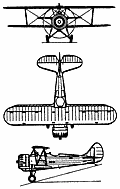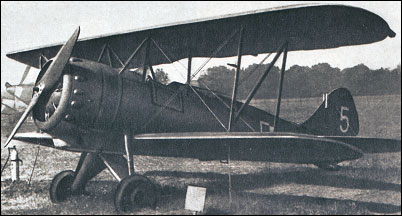|
| A development of the P.W.S.12/14, the
generally similar P.W.S.16 incorporated
a number of refinements, including
the provision of more efficient ailerons,
and the ensuing P.W.S.16bis differed
primarily by having a revised fuel system
to permit inverted flight. Production
totalled 20 of each, and the excellent
performance of these aircraft resulted in
large-scale production of an armed
trainer version, the P.W.S.26, which
also had structural strengthening for use
as a dive-bomber. The P.W.S.16/16bis
aircraft entered service with Polish air
force training units during 1934-35, being
relegated to secondary roles when the
P.W.S.26 became available in 1937.
When production of this last version
ended in 1938 a total of 250 had been
built and some of these were seized by
German forces in September 1939. A
number were operated by the Luftwaffe,
and Germany disposed of 28 refurbished
aircraft to Romania. However,
the majority of the P.W.S.26s were captured
by the Soviets, and many of these
entered service with the VVS.
 | A three-view drawing (650 x 1020) |
| MODEL | P.W.S. 26 |
| ENGINE | 1 x Wright J-5 Whirlwind radial piston engine, 164kW |
| WEIGHTS |
| Take-off weight | 1162 kg | 2562 lb |
| Empty weight | 850 kg | 1874 lb |
| DIMENSIONS |
| Wingspan | 9 m | 30 ft 6 in |
| Length | 7.03 m | 23 ft 1 in |
| Height | 2.75 m | 9 ft 0 in |
| Wing area | 24 m2 | 258.33 sq ft |
| PERFORMANCE |
| Max. speed | 215 km/h | 134 mph |
| Ceiling | 4620 m | 15150 ft |
| Range | 460 km | 286 miles |
| ARMAMENT | 1 x 7.7mm machine-guns |
| lxbfYeaa, e-mail, 14.03.2024 05:25 20 reply | | jarecki, e-mail, 21.03.2008 15:35 Yes, it was. Sometimes was used as recon or liaison duty. Propably this type of plain made last operational fly in Polish Campanion in 3 Oct.1939, Crew attacked German's forces using hand grenades. reply | | Les, e-mail, 21.06.2007 16:06 was this aircraft in anyway involved in WWII in any role? reply |
|
Do you have any comments?
|
| 
All the World's Rotorcraft |






